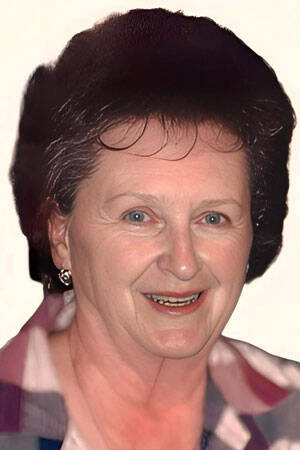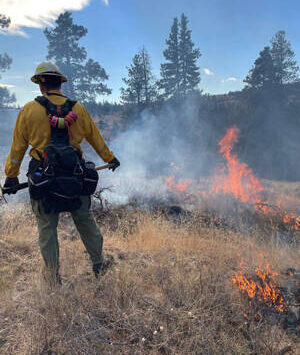- TONASKET – A visit by the Upper Columbia Salmon Recovery Board may turn out to provide the impetus needed to develop a solution to chronic problems with pollution, water flow and salmon habitat on Bonaparte Creek, which flows to the Okanogan River past the south side of Tonasket.
- Don McIvor, Natural Resources Coordinator of the UCSRB, and Ken Bevis of the Washington Department of Fish and Wildlife, were on hand at the Tuesday, May 8, Tonasket City Council meeting to share the mission of the Salmon Recovery Board, as well as seek recognition by the council of a recent reorganization of the lead entities of the organization, which were consolidated and removed from mixing with county government entities.
- “Lead entities are the state’s investment in assuring accountability in this process,” McIvor said. “It’s based around a structure that includes a scientific team that provides oversight and review or projects, and a citizens group that provides a social check on the projects.
- “The lead entities take technical direction from the recovery plan and a biological strategy which was developed around the plan. They look for project applicants, help them develop proposals, rank the proposals and send them to the state level, where they do a final review and allocate available funds to the top-ranked projects.”
- In a question-and-answer session following the presentation, Mayor Patrick Plumb noted the work put in on the Bonaparte Creek area.
- “We put a lot on the line without a lot of support from other entities,” Plumb said. “I think we’re starting to round the corner by getting the human fecal coliform hot spots out. I still would like to see more work done there. I don’t know what this board could do now, but it’s one of the northernmost points of pretty cold water if we can keep the flow up. I’d like to keep working to improve that part of the watershed. The tribe is raring to go on something up there if we could get something going up here.”
- Plumb said it was hard to know the impact until one could see a live steelhead run going up the creek when it has a good flow. Other pollution is also a problem, he said.
- “People think that it’s just a dump,” Plumb said. “It’s already worse this week after it had recently been cleaned up… ”
- “This might be worth looking into with Don for some specific action items,” Bevis said. “If we could come up with a concrete next set of steps.”
- “Mr. Mayor, if I can offer a thought, there are a lot of funding opportunities that could be presented in context of the next step,” Bevis said. “If you could draft a concrete proposal and if it could obviously benefit the fish, you could probably get it funded.”
- “What I’m talking about is wild salmon habitat improvement,” Plumb said. “The run we’ve had the last two years showed me they’re already here…. but that five years of work, Mr. (Scott) Olson’s trying to keep it clean, but there’s not enough dumpsters.
- “If we could take ownership of keeping that watershed clean, and for it to be good fish habitat.”
- “Perhaps we could work up a brainstorm on Bonaparte,” Bevis said after more discussion. “We need to figure out what the next steps are and tie it into broader funding, not just the conservation district.”
- McIvor cited the fact that in the 1800s, there were approximately 13 million wild salmon of various types in the Columbia River system; currently there are only about 220,000 (not including hatchery fish).
- The Upper Columbia Salmon Recovery Board is a non-profit organization that facilitates putting plans into action that can help with salmon recovery. Some past changes include using selective harvest gear; use of sport fishing to remove hatchery fish from natural spawning grounds; changing hatchery practices as mandated by Congress such as fin clipping to mark hatchery fish; and removing blocks to fish passage, and opening side channels to facilitate habitat restoration.
- Tonasket city planner Kurt Danison reported on a number of items:
- The county has continued to make progress in working out zoning restrictions to protect the areas surrounding small local airports, including a six month moratorium in place on building permits in area at either end of runways.
- “Lee Orr has been great as a representative,” Danison said. “He’s very thoughtful and very familiar with the issues.
- “The majority of the people on the committee are pilots and they are more concerned about the safety of people on the ground than about themselves. The county has a record of crashes at the ends of runways. Eventually we’ll have to take that up ourselves as a portion of the city is on the fringe of those areas.”
- Danison added that the reconfiguration of lots on the Eagle Canyon development south of the Tonasket airport has made it more palatable to the zoning committee.
- “They drastically reduced the number of lots,” he said. “It conforms to the intent of creating more open space. The decrease in density and increase in lot sizes is the model the want to see.”
- Regarding the city’s swimming pool, Danison said that the Recreation Conservation Office declared the the pool was obsolete. The city has five years to establish that is making substantial progress on replacing it. Danison said that he explained to the RCO that there was a fund in place, thanks to the gift given in the wake of Gordon Stangland’s death, and that the intent of the city was to move ahead.
- Additionally, Plumb reported that the lack of a permanent wheelchair lift in the pool may have forced the city to shut the pool down this year anyway.
- Danison said that Linda Black was making progress in seeking funding for a splash pad that could be built much sooner than the pool could be replaced.
- “History Park would seem to be the ideal place,” Danison said. “She seems to have the energy to pull it off and has been seeking donations. As she gets closer to funding it she’ll come to the council, and we’ll get it figured out.”
- Finally, Danison said he had been working with the Tonasket Beautification Committee, which has been making plans to spruce up the downtown area.
- “I’ve been trying to get input for our comprehensive plan, so the planning commission can get some input as no one comes to those meetings,” he said. “They confirmed that the goals should be the same. Their greatest interest is in physically going in and getting something done. It’s really exciting to see their energy.”
- He added that he’d asked Black and Chamber of Commerce president Dale Crandall for feed back on the economic development plan as well.
- Also, Police Chief Robert Burks was authorized to pursue a pair of grants that, if successfully applied for, could provide three years of wages for an additional officer and funding for a Dodge Charger police car. He was also granted permission to attempt to negotiate the purchase of a used Crown Victoria police car that, according to Burks, “is in better shape than anything we’re using now.”
- The council also rescheduled its regular June 12 meeting to Wednesday, June 13, due to the Tonasket Middle School’s promotion ceremonies that would directly affect at least two councilmembers.
- The Tonasket City Council next meets Tuesday, May 22, at 7 p.m.
Danison reports
Other actions
< /dt>




